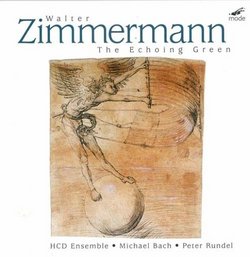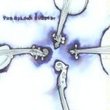| All Artists: Walter Zimmermann, HCD Ensemble, Hermann Kretzschmar Title: Walter Zimmermann: The Echoing Green Members Wishing: 1 Total Copies: 0 Label: Mode Original Release Date: 1/1/2005 Re-Release Date: 8/23/2005 Genre: Classical Styles: Chamber Music, Historical Periods, Classical (c.1770-1830) Number of Discs: 1 SwapaCD Credits: 1 UPC: 764593015024 |
Search - Walter Zimmermann, HCD Ensemble, Hermann Kretzschmar :: Walter Zimmermann: The Echoing Green
 | Walter Zimmermann, HCD Ensemble, Hermann Kretzschmar Walter Zimmermann: The Echoing Green Genre: Classical
|
Larger Image |
CD DetailsSimilar CDs
|
CD ReviewsOutsider with interestingly gentle situations scarecrow | Chicago, Illinois United States | 10/23/2006 (5 out of 5 stars) "Walter Zimmermann is a good example of an "outsider" like composer one not following the pack even within the corridors of established European and German music.
He found Feldman and Cage as a breath of fresher air,than Stockhausen or Lachenmann giving a more conceptual fluency to what he does, while acknowledging the "ends" of things, of theatre and music, of drama,the aesthetic and the role of the avant-garde. Instead to refurbish his music he finds relatively unusual situations,scouring diverse materials,texts,"sieves" and sources to build a context around in which a piece of music is composed. This agenda doesn't always guarantee success and when it doesn't work you know. The ear should be trusted/consulted always putting what is heard above the integrity of the concept, very post-modern I suppose. "Wandering in the desert"(Wuestenwanderung) (1986) is a gentle like piano solo, at least it begins this way, unassuming,like gentle wind chimes, you can listen all day,and all over the piano's registers are summoned but not commanded so much as gingerly requested,we cross different places on the piano crossing registers, and timbres, sometimes landing a focus on a repeated tone like a metaphor for travel. But as you listen this music works more for degrees of density, you seem to hear when more tones are introduced given the relative threadbare writing.You don't know if it is tonal, certainly not here but there is much euphoniousness timbres heard, tones blended that try to blend. The pianist must decide how much is blended or you could have a rather bleak situation. The piece the sheet music looks like a pointillistic affair until you hear it. It meanders "wanders" but not like it is lost in a style of musical language it doesn't know, it builds until the pianist recites,(shouts actually) text from Ezra Pound on Avarice "I was out of focus, taking a symptom for a cause".What better text to shout than that of arrogant Mr.Pound. It is an incredible piece for piano. Not so much with "Patience and opportunity" Sometimes the concepts utilzed here do make for an interesting situation. The cello and piano are employed as one timbre, one source,no accompaniment and work very close with rhythm to each other,we hear less, as in the repeated reiterations of a single tone, but largely with differing timbres.This sustains interest for a time and Cellist Michael Bach is marvelous here, (one of the premier avant-garde cellists who understands the conceptual fluidity in music)). The piece utilizes hieroglyphs from the Renaissance depictions of Mantegna and Rubens. Without these references the piece still functions,but the last movement called "Tyche" is a corrosive double stopped reiterations a la avant-garde,numbingly so again the use of a language but within another context,something Zimmermann always searches for.But here it implies a mindless violence we don't know of Zimmermann it doesn't work as well for long legths of time,it drains the listening constitution. In the more threadbare affair of "The Echoing Green"(after William Blake) for violin and piano a children's song is employed for "I am happy all year long". Here the "Sieve of Eratosthenes"is utilized to structure the tones in some way. This "Sieve" is a math procedure to chart prime numbers for the tones iterated herein." |

 Track Listings (6) - Disc #1
Track Listings (6) - Disc #1
